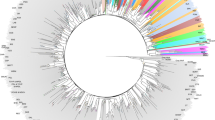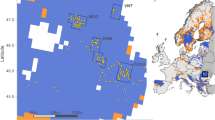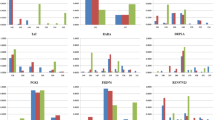Abstract
Fédération Cynologique Internationale (FCI) classifies a group of hound dogs in the sixth FCI group divided into three sections and three subsections that include 76 dog breeds. With the Istrian wire-haired hound, the Bosnian broken-haired hound—Barak is one of the two internationally recognized and standardized broken-haired hound breeds from the Balkans. However, genotyping of this breed has not been the subject of study so far. A total of 30 dogs (22 males and eight females) from different breeders from 17 locations in Bosnia and Herzegovina were selected for genotyping. All selected individuals had a valid pedigree issued by the Kennel Club in Bosnia and Herzegovina to ensure dogs were unrelated. Hairs with follicles were used for DNA extraction. Ten microsatellite loci from the commercial StockMarks® for Canine Genotyping Kit were amplified. Estimated genetic indices showed that Bosnian broken-haired hound—Barak harbors a high genetic variability. Phylogenetic relationships between Barak and the other 15 dog breeds, including Tornjak, another indigenous breed from Bosnia and Herzegovina, were assessed. An analysis showed clear differentiation of Barak, with Tornjak as the closest one among analyzed breeds. The results suggest that Barak, as we know it today, was developed during the formation of most modern breeds. Although Barak cannot yet be considered an endangered breed thanks to enthusiasts and hunters, the declining population trends impose the urgent need to establish an animal gene bank and programs for in situ conservation to protect and preserve this autochthonous breed of hound dog for future generations.




Similar content being viewed by others
References
Belkhir K, Borsa P, Chikhi L, Raufaste N, Bonhomme F (1996–2004) GENETIX 4.05, logiciel sous Windows TM pour la génétique des populations. Laboratoire Génome, Populations, Interactions, CNRS UMR 5000, Université de Montpellier II, Montpellier (France)
Brody JR, Kern SE (2005) Sodium boric acid: a Tris-free, cooler conductive medium for DNA electrophoresis. Biotechniques 38(1):60
Denise S, Johnston E, Halverson J, Marshall K, Rosenfeld D, Mckenna S, Sharp T, Edwards J (2004) Power of exclusion for parentage verification and probability of match for identity in American kennel club breeds using 17 canine microsatellite markers. Anim Genet 35:14–17
Dimitrijevic V, Stevanovic J, Savic M, Petrujkic B, Simeunovic P, Milosevic I, Stanimirovic Z (2013) Validation of 10 microsatellite loci for their use in parentage Verification and individual identification in the Yugoslavian shepherd dog Sharplanina. Ann Anim Sci 13(4):715–722
Evanno G, Regnaut S, Goudet J (2005) Detecting the number of clusters of individuals using the software structure: a simulation study. Mol Ecol 14(8):2611–2620
Excoffier L, Lischer HEL (2010) Arlequin suite ver 3.5: A new series of programs to perform population genetics analyses under Linux and Windows. Mol Ecol Resour 10:564–567
Irion DN, Schaffer AL, Grant S, Wilton AN, Pedersen NC (2005) Genetic variation analysis of the Bali street dog using microsatellites. BMC Genet 6:6
Katica V, Šakić V, Salkić A, Softić A (2006) Uzgojne i morfološke karakteristike bosansko-hercegovačko pastirskog psa tornjaka. Veterinaria 55(1–4):144–149
Katica V, Hadžiomerović Z, Salkić A, Šakić V, Softić A (2004) Autohtone pasmine domaćih životinja u Bosni i Hercegovini. Univerzitetski udžbenik. Promocult – Sarajevo. Sarajevo
Kim KS, Tanabe Y, Park CK, Ha JH (2001) Genetic variability in East Asian dogs using microsatellite loci analysis. J Hered 92:398–403
Koskinen MT, Bredbacka P (2000) Assessment of the population structure of five Finnish dog breeds with microsatellites. Anim Genet 31:310–317
Liu K, Muse SV (2005) PowerMarker: an integrated analysis environment for genetic marker analysis. Bioinformatics 21:2128–2129
Lüpke L, Distl O (2005) Microsatellite marker analysis of the genetic variability in Hanoverian Hounds. J Anim Breed Genet 122:131–139
Nikitović J (2020) Phenotypic and genotypic characterization of Bosnian broken-haired hound – Barak. Dissertation, University of Banja Luka (in Serbian)
Orban R (1958) Pasmine i sojevi autohtonih goniča Jugoslavije. Moj pas V(8–9):109–120
Parker HG, Kim LV, Sutter NB, Carlson S, Lorentzen TD, Malek TB, Johnson GS, Defrance HB, Ostrander EA, Kruglyak L (2004) Genetic structure of the purebred domestic dog. Science 304:1160–1164
Parra D, Méndez S, Cañón J, Dunner S (2008) Genetic differentiation in pointing dog breeds inferred from microsatellites and mitochondrial DNA sequence. Anim Genet 39:1–7
Peakall R, Smouse PE (2012) GenAlEx 6.5: genetic analysis in Excel. Population genetic software for teaching and research-an update. Bioinformatics 28:2537–2539
Pojskić N (2019) ALRATIO – R script for the analysis of relation between the effective and the detected number of alleles. Genet Applications 3(1):77–80
Pribanova M, Horak P, Schroffelova D, Urban T, Bechynova R, Musilova L (2009) Analysis of genetic variability in the Czech Dachshund population using microsatellite markers. J Anim Breed Genet 126:311–318
Pritchard JK, Stephens M, Donnelly P (2000) Inference of population structure using multilocus genotype data. Genetics 155:945–959
Puja IK, Irion DN, Schaffer AL, Pedersen NC (2005) The Kintamani dog: genetic profile of an emerging breed from Bali, Indonesia. J Hered 96:854–859
Šakić V, Katica V, Salkić A, Softić A (2006) Uticaj sezone parenja na odnos spolova i veličinu legla kod pasa rase tornjak. Veterinaria 55(1–4):46–50
Salkić A, Katica V, Šakić V, Softić A (2006) Karakteristike finoće dlake tornjaka na različitim lokalitetima Bosne i Hercegovine. Veterinaria 55(1–4):139–143
Schelling C, Gaillard C, Dolf G (2005) Genetic variability of seven dog breeds based on microsatellite markers. J Anim Breed Genet 122(Suppl. 1):71–77
Softić A, Katica V, Šakić V, Salkić A, Spahović-Salman M (2006) Osnovne eksterijerne karakteristike i značaj uzgoja bosansko-hercegovačko hrvatskog pastirskog psa tornjaka. Veterinaria 55(1–4):95–100
Softić A, Katica V, Ramić J, Bajrović K, Radosavljević G, Lasić L, Kalamujić B, Šakić V, Pojskić N (2016) Microsatelite diversity of Bosnian-Herzegovinian-Croatian shepherd dog Tornjak. Genetika 48(1):49–56
Urban T, Truksa M, Putnova L (2008) Analysis of genetic diversity in Caucasian Shepherd Dog and Czech Terrier dog breeds by using microsatellite loci. Biotechnology 1:409–411
Vilà C, Savolainen P, Maldonado JE, Amorim IR, Rice JE, Honeycutt RL, Crandall KA, Lundeberg J, Wayne RK (1997) Multiple and ancient origins of the domestic dog. Science 276:1687–1689
Völkel I (2005) Breed identification in Canis familiaris: Various approaches based on molecular genetic studies. Dissertation, Tierarztlichen Hochschule Hannover
Zajc I, Mellersh CS, Sampson J (1997) Variability of canine microsatellites within and between different dog breeds. Mamm Genome 8:182–185
Zenke P, Egyed B, Zoldag L, Padar Z (2011) Population genetic study in Hungarian canine populations using forensically informative STR loci. Forensic Sci Int Gen 5:31–36
Acknowledgements
The authors would like to thank all dog owners who consented to provide samples for this study.
Funding
The authors declare that no funds, grants, or other support were received during the preparation of this manuscript.
Author information
Authors and Affiliations
Contributions
JN, NP, and BKS contributed to the study conception and design. JN and ZM conducted all field research. JN, LU, and BKS contributed to material preparation, laboratory analysis, and data collection. NP and AK performed all statistical analyses. All authors participated in drafting the first version of the manuscript. All authors read and approved the final manuscript.
Corresponding author
Ethics declarations
Conflict of interest
The authors have no relevant financial or non-financial interests to disclose.
Research Involving Human and Animal Participants
No animals were harmed during this study.
Informed Consent
The material for the study has been collected by non-invasive method and with full consent of the dogs’ owners.
Additional information
Publisher's Note
Springer Nature remains neutral with regard to jurisdictional claims in published maps and institutional affiliations.
Rights and permissions
Springer Nature or its licensor holds exclusive rights to this article under a publishing agreement with the author(s) or other rightsholder(s); author self-archiving of the accepted manuscript version of this article is solely governed by the terms of such publishing agreement and applicable law.
About this article
Cite this article
Nikitović, J., Pojskić, N., Kalajdžić, A. et al. Genetic Diversity of Bosnian and Herzegovinian Autochthonous Dog Breed Bosnian Broken-Haired Hound—Barak. Biochem Genet 61, 901–915 (2023). https://doi.org/10.1007/s10528-022-10291-8
Received:
Accepted:
Published:
Issue Date:
DOI: https://doi.org/10.1007/s10528-022-10291-8




